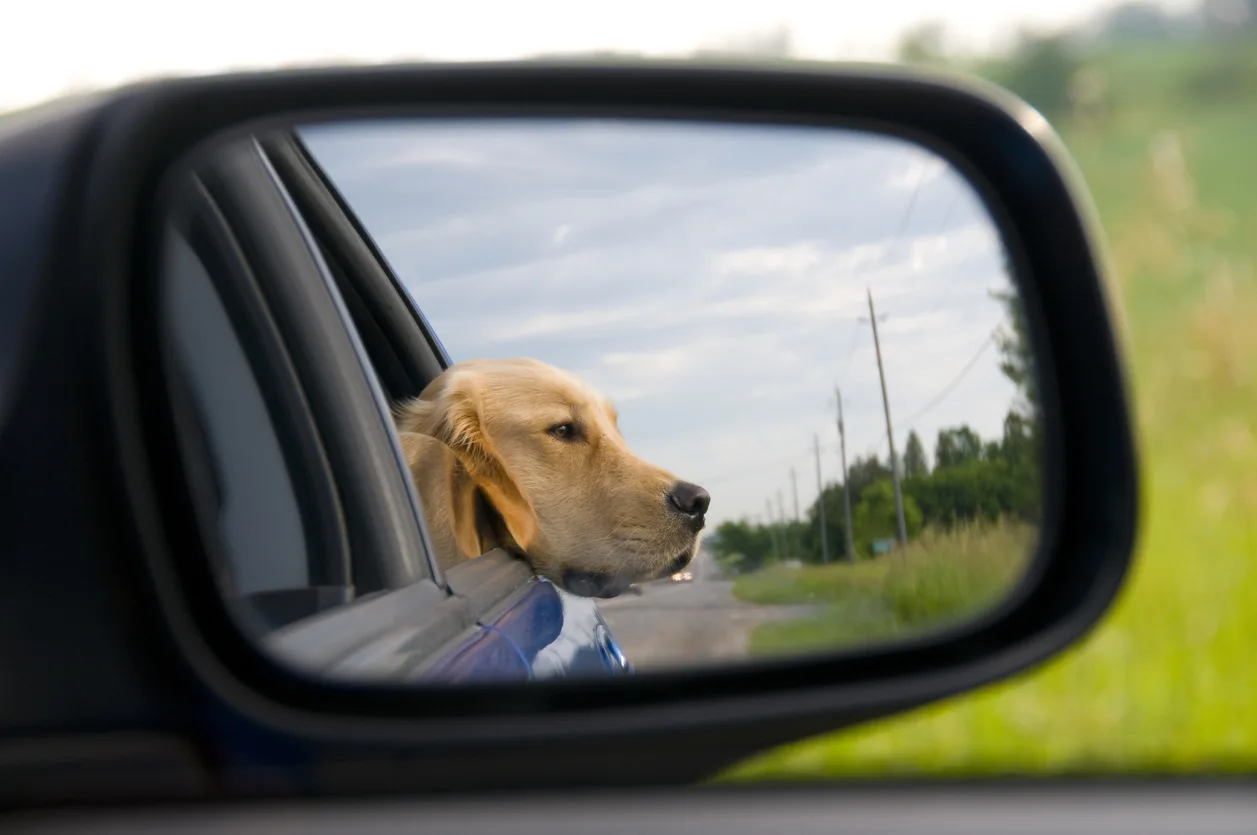Moving or traveling with a dog can be stressful right from the get-go. Not every pup handles being in the car, on a boat, or in the air. Some dogs become extremely stressed and anxious, while others experience canine vestibular upset – better known to most pet parents as motion sickness.
We can’t always avoid traveling with pets, even if they don’t handle the transportation well. Most dog owners agree that leaving Fido behind just isn’t an option in all but the most severe of cases. But that doesn’t mean you (or your dog) have to just accept motion sickness with no respite; a combination of medication and non-medication measures can make your pet more comfortable throughout the trip.
What Causes Dog Motion Sickness?
Motion sickness occurs in dogs for the same reasons it occurs in humans; it all starts with the canine vestibular apparatus in the ear. This structure is directly responsible for managing balance. The motion of a vehicle (of any kind) is unnatural for both humans and dogs alike. We know that the vestibular apparatus becomes stimulated with vehicular motion, and that it sends signals to the brain that trigger dizziness and vomiting.
In the wild, your dog’s vestibular apparatus would keep him upright and let him know when the ground underneath him is unstable, and thus, may present a danger to him. Without the vestibular apparatus, neither dogs nor humans would remain upright; we’d keel over in dizziness.
Dog Motion Sickness Symptoms
When pups experience motion sickness, they may vomit, have diarrhea, poor appetite, excessive drooling, lethargy, and even trembling. Dizziness or stumbling may occur if the animal isn’t fully restrained. All of these symptoms have a tendency to stack up, resulting in a furry friend that’s unhappy, unwell, and just generally miserable for the entire trip. If your dog begins to associate travel with sickness, the brain can begin to stack those symptoms even just at the sight of the vehicle itself.
Despite the fact that car, boat, and air sickness treatments all share similarities, it’s best to approach them from an individual perspective.
Car Sickness Remedies
The car is the most common place for your dog to experience motion sickness simply because he’s more likely to experience a car ride than a boat or airplane ride. Unfortunately, canine motion sickness can strike at any time on car rides — even if your pup hasn’t ever experienced it in the past. Worse yet, the severity of motion sickness isn’t tied to how long you travel; some dogs become sick even on short trips to the local park. Anxiety and stress in the vehicle will naturally worsen motion sickness, too.
That can make for one unhappy pup and a decidedly unhappy pet parent.
Of particular note is the importance of restraining your dog while in the vehicle. This isn’t just a safety issue; an unsecured dog will move around more, and thus, is likely to experience more motion sickness, too.
Prevention is worth a pound of cure here, so whenever possible, acclimatize your dog to the car before you start taking trips. Either way, the following strategy works for many dog owners.
Start when your dog has an empty stomach.
Hang out in the vehicle for 30 minutes to an hour a few times a week without moving. Make this fun for your dog; give lots of pats and love. Keep the temperature in the vehicle cool, as overheating can increase nausea, and keep the time in the car quiet, peaceful, and friendly.
As long as he isn’t actively vomiting, you can offer a treat or two, too. Once he seems okay with sitting in the vehicle for extended periods of time, turn the car on. Repeat the process with the vehicle on, but don’t start moving just yet.
After you’re sure your dog feels okay with sitting in the car while it’s on, try a short 10-minute trip. Avoid heavy curves or fast speeds for the first little while, and stop if your dog shows symptoms.
If your dog continues to experience motion sickness despite these attempts, speak to your vet about medication. Do not give any human medication, like sedatives or anti-nausea medications, without the express permission of your vet.
Sea Sickness Remedies
Despite the sheer frequency of car sickness in dogs, your pup has a higher chance to experience motion sickness on a boat. The rocking motion of the water throws the vestibular apparatus off, causing the brain to become confused. The risk for boat sickness in dogs increases with smaller boats, so your furry friend is more likely to become sick on a speedboat than on a cruise ship.
Boat sickness is especially concerning because dogs may be loose, and dizziness can cause them to fall overboard if proper safety measures aren’t followed. Always keep your dog on a leash on smaller boats, and whenever possible, have him wear a life vest or jacket, too.
First, desensitization methods like the strategy mentioned above do often work for boat sickness, too. But if desensitization doesn’t work, you may need a special approach that combines the use of medication with a little bit of avoidance.
If your dog shows signs of motion sickness on a boat, assess your situation. Is the water rough? Is the weather poor? High winds and bad weather can increase the risk of rough waters, and the rougher the water is, the more likely your dog is to become sick. Avoid sailing on rough waters whenever possible.
Watch your pup carefully the next time you’re out boating. Occasionally, dogs may drink salt water, and this can induce symptoms like motion sickness that really stem from the ingestion itself. Be sure that your pup has access to fresh water at all times.
If all else fails, you’ll have to determine whether being on the water matters enough to continue the activity with your dog. If it’s just a recreational sail, it may be best to leave him at home. If it’s moving, medication may help.
Air Sickness Remedies
Air sickness is a much more difficult form of motion sickness to tackle because dogs are typically locked away in a special cargo section of the airplane. If they become sick, it’s up to flight attendants and staff to address their needs. That can result in an incredibly anxious pup and and even more anxious parent.
The good news is that air sickness is often related more to anxiety than to true motion sickness, especially on larger jets like the Boeing 747. Sometimes, calming medications or Sentry calming collars are enough to relax your dog to a point that he can rest well throughout the flight. In other cases, your pup may need full sedation or anti-nauseants to get through the trip. Your vet is the best judge of which solution is best for your dog.
One frequently overlooked detail is carrier size. Proper restraint within the air cargo unit is vital, both to preventing symptoms and to safety.
Your dog’s carrier should be airline-approved and large enough for your pet to stand up, turn around, and lie down safely. Carriers that are too large or too small both pose additional risks to your pet, and will only increase the risk of motion sickness symptoms.
Whenever possible, acclimatize your dog to at least her carrier for several weeks in advance. Leave it sitting open in the living room, and put in a few treats. Encourage her to treat it as if it were her den. This will reduce anxiety on flight day.
Whether you’re flying, driving, or sailing, there’s always a risk that your dog will experience motion sickness. Even dogs who have never experienced symptoms can begin to experience them later in life, as the vestibular apparatus ages and loses function. The most important action you can take for your pup is to visit the vet when symptoms crop up. Your dog doesn’t need to suffer unnecessarily with nausea and dizziness with medication and training methods.

